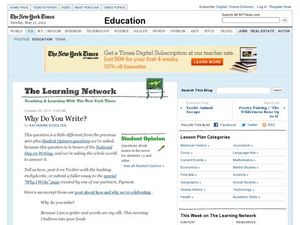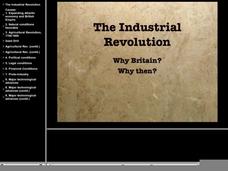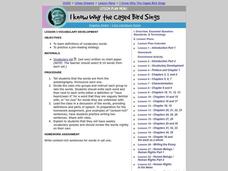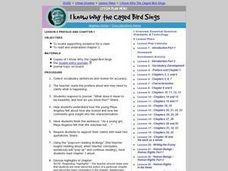Curated OER
Why Do You Write?
Ask your learners this question as a quickwrite: why do you write? This prompt can begin a unit on writing and open up a dialogue about the motivations writers have. Tap into your scholars' reasons for writing and make the activity more...
Curated OER
Why Polar Bears Are White
Pupils are introduced to the concept of camouflage and protective coloration as well as Arctic animals. They examine how color can help animals in the wild. Students discuss where polar bears live and why they are white.
Curated OER
Why Are Plants Green?
Students smash plant parts and wait for visibility of chlorophyl to show why plants turn green. In this green plants lesson plan, students use acetone and filter paper for this experiment.
Roy Rosenzweig Center for History and New Media
Immigration: Why Come to the United States?
Don't limit your curriculum to texts! Young historians listen to a song, read an interview, and examine a cartoon as they explore motivations for immigrating to the US in the late 19th and early 20th centuries.
PBS
Why Isn't There an Eclipse Every Month?
Searching for an eclipse activity that sends scholars over the moon? Try an interesting interactive to get their minds active! The resource, part of an extensive Space series from PBS Learning Media, uses modeling and data analysis to...
Curated OER
The Industrial Revolution: Why Britain? Why Then?
Why did the Industrial Revolution start in Great Britain? Cover the causes, climate, inventions, and technology that made Britain ripe for modern industrialization on a massive scale.
Federal Reserve Bank
Why Scarce Resources Are Sometimes Unemployed
Why do markets operate inefficiently when the world's resources are so limited? Review the various types of unemployment that exist and why some resources, especially human resources, go unused.
Council for Economic Education
Out of Africa: Why Early Humans Settled around the World
Why would someone want to leave home? The age-old question is at the center of a thought-provoking activity. Scholars consider why humans move around the world both during pre-historical times and today using a PowerPoint, reading on...
EngageNY
Using Quotes to Explain: Why Philo Farnsworth Invented Television
Television or radio? Scholars read pages 18-28 of The Boy Who Invented TV: The Story of Philo Farnsworth to discover why Farnsworth thought TV was better than radio. They determine the gist of the section and then look closer at why...
C3 Teachers
Reparations: Why Are Reparations Controversial?
To understand why the topic of reparations is controversial, young scholars gather background information by reading articles, watching videos, and examining cases where reparations were made. Learners consider the lasting repercussions...
Alabama Learning Exchange
Who, What, When, Where, Why, How?
Your youngsters are just starting to read texts and pull out important information. Use this graphic organizer with any text to help them practice identifying the who, what, when, where, why, and how of a text. Although the format of the...
Colorado State University
Why Are Compact Fluorescent Bulbs More Efficient?
Compact fluorescent bulbs are the easiest way to increase energy efficiency around the house. But why? Science scholars compare CF bulbs with their incandescent counterparts using a simple test. A solar-powered toy illuminates the...
EngageNY
Building Background Knowledge and Summarizing: “Refugees: Who, Where, Why” Part 2
What are some universal aspects of refugees' experiences worldwide and throughout history? Scholars read the text "Refugees: Who, Where, Why" and create two class anchor charts. Finally, they each write a paragraph that provides an...
EngageNY
Building Background Knowledge, Predicting, and Focusing on Key Vocabulary: “Refugees: Who, Where, Why”
Using the fourth of 20 lessons from the Grade 8 ELA Module 1, Unit 2 series, scholars discuss refugees' challenges when finding a place to call home. They also read and answer text-based questions about the informational passage...
EngageNY
Finishing Who? Where? and Why? Research
Who? Where? Why? Scholars answer these questions to help identify the gist of Inside Out & Back Again. First, they add text evidence to their research folders. They then begin looking at a performance task in which they write their...
EngageNY
Mid-Unit Assessment: Evidence, Ideas, and Interactions in “Why Couldn’t Snow White Be Chinese?”
The class is halfway there! Pupils complete a mid-unit assessment by answering questions in Evidence, Ideas, and Interactions in Why Couldn’t Snow White Be Chinese? Readers then work with partners to analyze the 2010 Census: United...
National Science Teaching Association
Why Do We All Have to Stay Home?
Learners, especially young ones, might be confused about why or frustrated that we have to stay at home. Help answer questions and calm emotions with a nine-page resource that details topics regarding the COVID-19 pandemic.
Tean Truth
Who Do You Admire and Why?
A five-question worksheet asks learners to consider who they admire, the qualities this person has that they admire, and why they find these characteristics admirable. To conclude, pupils select three of the qualities they admire in...
Angel Island Immigration Station Foundation
Conditions in China: Why Might One Leave Home Forever?
Primary source texts provide scholars with the background information they need to understand why Chinese peasant farmers were driven to emigrate. After underlining keywords, phrases, and/or lines in the texts, individuals craft a...
Curated OER
I Know Why the Caged Bird Sings: Human Rights
Students use Maya Angelou's I Know Why the Caged Bird Sings as analysis on human rights. In this human rights lesson, students develop an awareness of human rights issues and explore the Universal Declaration of Human Rights using the...
Curated OER
I Know Why the Caged Bird Sings
Students read and analyze the novel "I Know Why the Caged Bird Sings" by Maya Angelou. They discuss the poetry and prose of the book, the importance of role models, complete a worksheet, and write a narrative using figurative language.
Curated OER
I Know Why the Caged Bird Sings: Human Rights
Students define the universal rights of human beings. In this human rights lesson, students visit the website about the Universal Declaration of Human Rights and read all parts of the document. Students discuss why there is a need for...
Curated OER
I Know Why the Caged Bird Sings
Learners complete vocabulary activities for Maya Angelou's I Know Why the Caged Bird Sings. Students review a list of vocabulary words from the text and rate the words. Learners write each word and a definition. Students discuss the...
Curated OER
I Know Why the Caged Bird Sings: Preface and Chapter 1
Students complete chapter analysis activities for Maya Angelou's I Know Why the Caged Bird Sings.In this chapter analysis lesson plan, students read the preface and chapter 1 and complete vocabulary activities, journal activities, and...
Other popular searches
- Why Study Classical Music
- Who What When Where Why How
- Why Are Dinosaurs Extinct
- Why Foreign Languages
- Why Study History
- Why Do People Dance?
- Why Stories
- Why Characters Have Actions
- Why Study Global Cultures
- Who What Where When Why
- Why Mosquitoes Buzz
- Why Climate and Crops

























